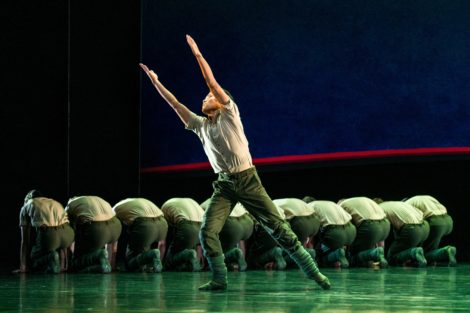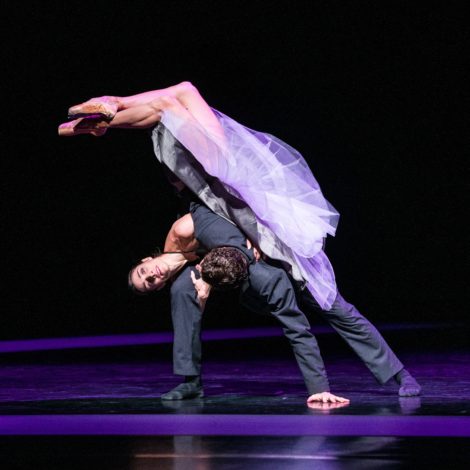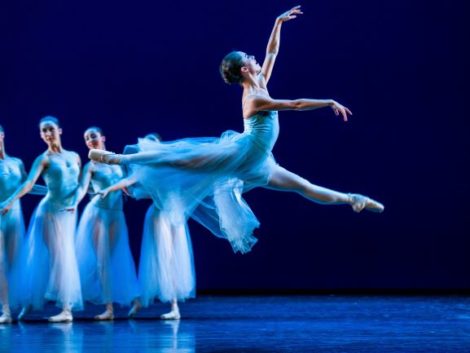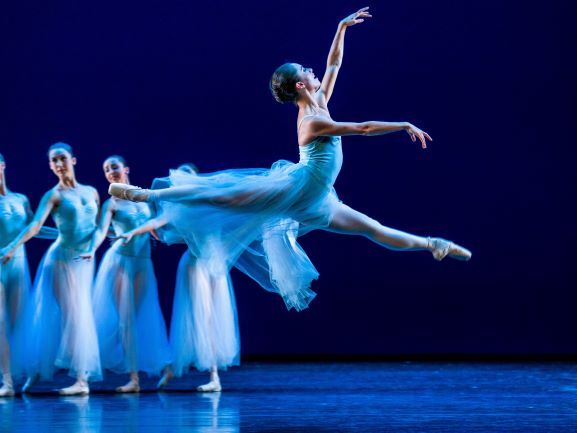17 May 2019. Lyric Theatre, Queensland Performing Arts Centre, Brisbane
One of the strongest aspects of Queensland Ballet’s programming at the moment is Li Cunxin’s masterful ability to curate an engrossing triple bill. This is no easy task, but it is something that has characterised the work of the best companies across the decades. The Masters Series, the current Queensland Ballet offering, is no exception. Li has put together an exceptional triple bill. It gives us George Balanchine’s Serenade, and Jiří Kylián’s Soldier’s Mass, both outstanding works from two of the world’s most respected choreographers. These two works are joined by a new work, The Shadows Behind Us, from American choreographer Trey McIntyre.
I have no hesitation in saying that, for me at least, Serenade, the first work of the evening, was the highlight. It was the first original work that Balanchine created in America, and it gives a foretaste of what his future works would be like—at least from a technical point of view. At times the spatial patterns Balanchine creates are so arresting that they seem to be the main feature of the work. He is a master of placing dancers on, and moving them around the stage.
But looking beyond the beautiful patterns, the steps that Balanchine asks of the dancers are complex— full of turns and fast footwork—and the dancers of Queensland Ballet rose to the occasion. Standout performances came from Yanela Piñera and Victor Estévez, who had the main pas de deux, and Lucy Green, Georgia Swan and Patricio Revé, who had soloist roles. The final few moments in which these dancers held the stage were quite moving. But the entire corps de ballet danced with thrilling technique throughout, and with a great feeling for the changing moods of the ballet.

(from top) Georgia Swan, Patricio Revé and Yanela Piñera in Serenade, Queensland Ballet, 2019. Photo: © Darren Thomas
The closing work was Kylián’s Soldiers’ Mass a work for 12 male dancers with choreography that is driving and relentless. The fascinating aspect of the work is the way in which Kylián manipulates the group. The dancers form into lines, break apart, regather, divide up again, leaping, falling, and partnering each other, and moving all the time to the very powerful 1939 composition by Bohuslav Martinu, Field Mass. Kylián’s work is a comment on war and the emotional toll it takes on those who are forced to engage in it. Emotion and drama surge throughout the work. Kohei Iwamoto was the star for me. Whether in his solos, or when he was dancing with his fellow soldiers, every inch of his body told the story. But then every dancer seemed totally committed.

In the middle, The Shadows Behind Us was, for me, the least successful work of the evening. Danced to songs by Jimmy Scott, it was brash and slick in an American idiom. Made on ten dancers, it consisted basically of six duets, including one between two men, in which relationships were played out. The set by Thomas Mika was a great addition to the work. It gave some kind of narrative element to the action. It consisted of a large white frame, or partial frame, in the downstage area, forming a kind of proscenium where the action was located. Behind it was a black void into which the dancers disappeared as they finished their duet (the shadows behind us). But I have to admit to finding the choreography quite stilted in many respects and some of the poses the men were asked to take seemed quite awkward.

Despite my reservations about The Shadows Behind Us, The Masters Series was a great evening of dance, and a triple bill that fulfilled one’s expectations of the variety of dance that good mixed bills should contain.
Michelle Potter, 20 May 2019
Featured image: Lucy Green and dancers in Serenade, Queensland Ballet, 2019. Photo: © Darren Thomas


What a shaft of joyful recognition to sight Kohei Iwamoto in Soldier’s Mass. That Kylian classic was strongly performed across several seasons by RNZB, and (“our”) Kohei is remembered in it yet.
In the first staging, 1998, (only 21 years ago. How strong a good dance memory can be…) a male dancer injured, none to replace him, so Pieter Symonds stepped up to the challenge. It was hard to take our eyes off her astonishing presence, and I thought of her as Joan of Arc.
History repeated in the return season when Laura Saxon Jones replaced an injured male, and again we quivered and held our breath to see how a woman can dance in battle.
What a choreographic classic this work is, joining us to Kylian’s splendid repertoire.
Dance history is never quite finished of course. Although Laura, inexplicably, is no longer dancing with RNZB, she will perform tonight at Victoria University, with musicians from New Zealand School of Music. It takes courage and ingenuity to survive as a free-lance independent ballet dancer, but Laura has always had those qualities in spades. I’ll let you
know how the dance goes tonight.
Good to have a bit of NZ background Jennifer. Thank you.
As for Kohei, the image that keeps coming back to me is from that moment when all then men are standing downstage and singing the words of the Mass. He was singing with his body, as it were, as the physical energy he was bringing to the role was still absolutely obvious. Such is the power a dancer has. When just standing still, looking straight ahead and singing, the dancer is still dancing.